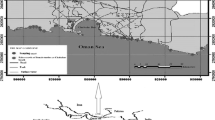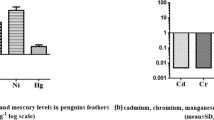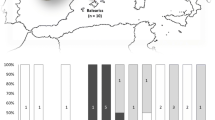Abstract
On the basis of earlier reports on high selenium levels in organs of marine waders from the Dutch Wadden Sea, adverse effects in wader reproduction were anticipated. A local breeding population of the wader Haematopus ostralegus, oystercatcher, was examined for embryotoxicity and selenium levels in eggs and parental blood. Egg and/or blood samples from breeding oystercatchers were obtained also from two reference sites, a Dutch meadow nature reserve and a Norwegian Atlantic island. The blood selenium levels were high in the Dutch marine birds (red blood cells contained 21 mg/kg vs 0.1–1.2 mg/kg dry weight in man), but the highest red blood cell levels were recorded in the red cells of birds sampled at the Norwegian reference site (maximal value 42 mg/kg dry weight). Both the concentrations in eggs from the Wadden Sea and in eggs from inland pastures (about 2 mg/kg dry weight), were at background level and embryotoxicity was not observed. Considering the results, it was concluded that selenium is not a potential threat to the reproduction of waders from the Dutch Wadden Sea, despite the high selenium concentrations in the tissues of the waders foraging in this area. Selenium in egg white was about 1.6 times higher than in yolk. The first egg had a 10% higher egg white and a 19% higher yolk concentration compared to the subsequent eggs in the coastal clutches. Red blood cell levels were about 3.5 times higher in marine feeding birds than in inland feeding birds. Selenium concentrations in the plasma and red blood cells were positively correlated.
Similar content being viewed by others
References
Arnold RL, Olson OE, Carlson CW (1973) Dietary selenium and arsenic additions and their effects on tissue and egg selenium. Poultry Sci 52:847–854
Behne D, Wolters W (1983) Distribution of selenium and glutathione peroxidase in the rat. J Nutr 113:456–461
Blus LJ, Neely BS, Lamont TG, Mulhern B (1977) Residues of organochlorines and heavy metals in tissues and eggs of Brown pelicans, 1969–73. Pestic Monit J 11:40–53
Briggs K (1984) The breeding ecology of coastal and inland Oystercatchers in north Lancashire. Bird Study 31:141–147
Cramp S, Simmmons KEL (1983) The birds of the western Palearctic. Vol 3. Waders to gulls. Oxford Univ Press, Oxford.
Echevarria MR, Henry PR, Ammerman CB, Rao PV, Miles RD (1988a) Estimation of the relative bioavailability of inorganic selenium sources for poultry. 1. Effect of time and high dietary selenium on tissue selenium uptake. Poultry Sci 67:1295–1301
—, —, — (1988b) 2. Tissue uptake of selenium from high dietary selenium concentrations. Poultry Sci 67:1585–1592
Eisler R (1985) Selenium hazards to fish, wildlife and invertebrares: a synoptic review. Contaminant Hazard Reviews, Report no 5, US Fish and Wildlife Service, US Dept Interior
— (1988) Arsenic hazards to fish, wildlife and invertebrares: A synoptic review. Contaminant Hazard Reviews, Report no 12, US Fish and Wildlife Service, US Dept Interior, Washington, DC
Focardi S, Fossi C, Lambertini M, Leonzio C, Massi A (1988) Long term monitoring of pollutants in eggs of yellow-legged herring gull from Capria island (Tuscan Archipelago). Environ Monit Assess 10:43–50
Franke KW, Moxon AL, Poley WE, Tully WC (1936) Monstrosities produced by the injection of selenium salts into hens' eggs. Anatom Rec 65:15–22
Goede AA (1985) Mercury, selenium, arsenic and zinc in waders from the Dutch Wadden Sea. Environ Pollut 37:287–309
Goede AA, Nygard T, de Bruin M, Steinnes E (1989) Selenium, mercury, arsenic and cadmium in the life cycle of the dunlin, Calidris alpina, a migrant wader. Sci Total Environ 78:205–218
Goede AA, Wolterbeek HTh, Koese MJ (1993) Selenium concentrations in the marine invertebrates Macoma balthica, Mytilus edulis, and Nereis diversicolor. Arch Environ Contam Toxicol 25:85–89
Goede AA, Wolterbeek HTh (in press) Have high selenium concentrations in wading birds their origin in mercury? Sci Total Environ
Glutz von Blotzheim UN (1975) Handbuch der Vögel Mitteleuropas. Akad Verlagsgesellsch, Wiesbaden
Hassan S, Hakkarainen RVJ, Lindberg PO (1987) Bioavailability to chicks of selenium in barley, oats and meat meal. Acta Vet Scand 28:81–92
Heinz GH, Hoffman DJ, Gold LG (1988) Toxicity of organic and inorganic selenium to mallard ducklings. Arch Environ Contam Toxicol 17:561–568
Heinz GH, Hoffman DJ, Gold LG (1989) Impaired reproduction of mallards fed an organic form of selenium. J Wildl Manage 53:418–428
Heinz GH, Hoffman DJ, Krynitsky AJ, Weller DMG (1987) Reproduction in mallards fed selenium. Environ Toxicol Chem 6:423–433
Henny CJ, Herron GB (1989) DDE, selenium, mercury, and white faced Ibis reproduction at Carson lake, Nevada. J Wildl Manage 53:1032–1045
Hoffman DJ, Heinz GH (1988) Embryotoxic and teratogenic effects of selenium in the diet of mallards. J. Toxicol Environ Health 24:477–490
Hoffman DJ, Sanderson CJ, LeCaptain LJ, Cromartie E, Pendleton GW (1992) Interactive effects of arsenate, selenium, and dietary protein on survival, growth, and physiology in mallard ducklings. Arch Environ Contam Toxicol 22:55–62
King AK, Lefever CA, Mulhern BM (1983) Organochlorine and metal residues in Royal terns nesting on the central Texas coast. J Field Ornithol 54:295–303
King AK, Blankinship DR, Payne E, Krynitsky AJ, Hensler GL (1985) Brown pelican populations and pollutants in Texas 1975–1981. Wilson Bull 97:201–214
King AK, Custer TW, Quinn JS (1991) Effects of mercury, selenium, and organochlorine contaminants on reproduction of Forster's terns and Black skimmers nesting in a contaminated Texas Bay. Arch Environ Contam Toxicol 20:32–40
Latshaw JD, Osman M (1975) Distribution of selenium in egg white and yolk after feeding natural and synthetic selenium compounds. Poultry Sci 54:1244–1252
Lonzarich DG, Harvey TE, Takekawa JE (1992) Trace element and organochlorine concentrations in California Clapper rail (Rallus longirostris obsoletus) eggs. Arch Environ Contam Toxicol 23:147–153
Ohlendorf HM, Hothem RL, Bunck CM, Aldrich TW, Moore JF (1986) Relationships between selenium concentrations and avian reproduction. Trans North Am Wildl Nat Resour Conf 51:330–342
Ohlendorf HM, Harrison CS (1986) Mercury, selenium, cadmium and organochlorines in eggs of three Hawaiian seabird species. Environ Pollut 11:169–191
Ohlendorf HM, Hothem RL, Aldrich TW, Krynitsky AJ (1987) Selenium contamination of the grasslands, a major California waterfowl area. Sci Total Environ 66:169–183
Ohlendorf HM, Kilness AW, Simmons JL, Stroud RK, Hoffman DJ, Moore JF (1988) Selenium toxicosis in wild aquatic birds. J Toxicol Environ Health 24:67–92
Ohlendorf HM (1989) Bioaccumulation and effects of selenium in wildlife. In: Jacobs LW (ed) Selenium in agriculture and the environment. Spec Publ No. 23, Am Soc Agronomy, Madison, WI, pp 133–177
Pelletier P (1985) Mercury-selenium interactions in aquatic organisms: A review. Mar Environ Res 18:111–132
Renzoni A, Focardi S, Fossi C, Leonzio C, Mayol J (1986) Comparison between concentrations of mercury and other contaminants in eggs and tissues of Cory's shearwater Calonectris diomedea collected on Atlantic and Mediteranean islands. Environ Pollut 40:17–35
Smith GJ, Heinz GH, Hoffman DJ, Spann JW, Krynitsky AJ (1988) Reproduction in black-crowned night-herons fed selenium. Lake Reservoir Manage 4:175–180
Spyrou NM, Akanle OA, Dhani A (1988) Nuclear-based methods for the study of selenium. Trans Am Nucl Soc 56:149–150
Thomassen Y, Aaseth J (1989) Human tissues. In: Ihnat M (ed) Occurrence and distribution of selenium. CRC, Boca Raton, FL
Woittiez JRW (1988) Neutron activation of selenium and arsenic with or without chemical separation. Trans Am Nucl Soc 56:150–151
Author information
Authors and Affiliations
Rights and permissions
About this article
Cite this article
Goede, A.A. Selenium in eggs and parental blood of a Dutch marine wader. Arch. Environ. Contam. Toxicol. 25, 79–84 (1993). https://doi.org/10.1007/BF00230715
Received:
Issue Date:
DOI: https://doi.org/10.1007/BF00230715




